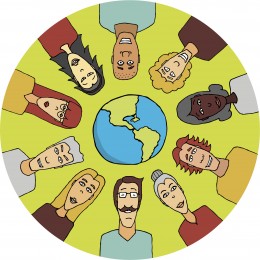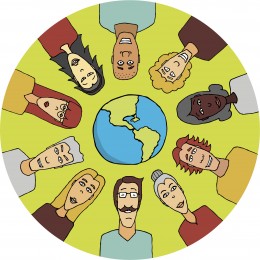 Yeah, yeah, you know — the world population is hitting 7 billion this year. Here are some facts about the world’s people that you might not already be familiar with.
Yeah, yeah, you know — the world population is hitting 7 billion this year. Here are some facts about the world’s people that you might not already be familiar with.
50,000 — years it took for the human population to reach 1 billion, in 1800 1
12 — years it took to add the latest billion, in 2011 2
12 — projected number of years it could take to add the next billion, by 2023 2
9.3 billion — potential world population in 2050, according to the U.N.’s medium projection 3
10.1 billion — potential world population in 2100, according to the U.N.’s medium projection 3
15.8 billion — potential world population in 2100 if fertility rates don’t fall as much as expected, according to the U.N.’s high projection 3
158 — people added to the planet every minute (births minus deaths) 4
227,252 — people added to the planet every day 4
82,947,000 — people added to the planet every year 4
100-1,000 — factor by which the extinction rate of species has increased since Homo sapiens came onto the scene 5
15-37 — percentage of existing species expected to be pushed to extinction by 2050 because of human-driven climate change 6
60 — percentage of key ecosystem services (freshwater, air and water purification, etc.) degraded or used unsustainably by humans over the last 50 years 7
350,000 — number of Endangered Species Condoms the Center for Biological Diversity gave away in 2010 8
100,000 — number of Endangered Species Condoms the center plans to give away this fall, with your help 8
5.0 — number of children born to the average woman in 1950 9
2.5 — number of children born to the average woman today 4, 9
2.0 — number of children born to the average woman in the U.S. 4
0.9 — number of children born to the average woman in Taiwan, the country with the world’s lowest fertility rate 4
7.0 — number of children born to the average woman in Niger, the country with the world’s highest fertility rate 4
215 million — number of women in the world who want to prevent or delay pregnancy but don’t have access to modern contraception 10
$16.9 billion — estimated annual cost of providing family-planning services to all women in developing countries 11
$20.8 billion — amount Wall Street firms paid out in bonuses in 2010 12
1.25 billion — number of people living in more developed countries 4
5.75 billion — number of people living in less developed countries 4
100 — percentage of future population growth expected to happen in less developed countries 13
1.35 billion — population of China, the most populous nation on earth 4
1.24 billion — population of India, the second most populous nation 4
312 million — population of the U.S., the third most populous nation 4
5.8 — metric tons of CO2 emitted per person in China 14
1.4 — metric tons of CO2 emitted per person in India 14
17.7 — metric tons of CO2 emitted per person in the U.S. 14
4.5 — percentage of world population living in the U.S. 15
18 — percentage of global CO2 from fossil-fuel burning emitted in the U.S. 16
1 — rank of the U.S. in terms of overall global energy consumption 17
18 — number of languages the Voluntary Human Extinction Movement website has been translated into 18
0 — chance of the Voluntary Human Extinction Movement achieving its goal

Read more on population. Check out our series 7 Billion: What to expect when you're expanding
Sources:
Hat tips to Vicky Markham and Laurie Mazur.
1. “What If Experts Are Wrong On World Population Growth?” by Carl Haub, Yale Environment 360. “Scientists Rough Out Humanity’s 50,000-Year-Old Story,” by Nicholas Wade, New York Times Learning Network.
2. “Population Bulletin: The World at 7 Billion,” Population Reference Bureau.
3. “World Population to Reach 10 Billion by 2100 if Fertility in All Countries Converges to Replacement Level” [PDF], United Nations.
4. “2011 World Population Data Sheet,” Population Reference Bureau.
5. “GEO-4 Fact Sheet 7: Biodiversity and Human Well-Being” [PDF], United Nations Environment Program. “About the IUCN Red List,” IUCN.
6. “Extinction risk from climate change,” by Chris D. Thomas et al., Nature.
7. “Ecosystems and Human Well-Being: Synthesis” [PDF], Millenium Ecosystem Assessment.
8. “Endangered Species Condoms,” Center for Biological Diversity.
9. “9 Billion?” by Leslie Roberts, Science.
10. “Facts on Investing in Family Planning and Maternal and Newborn Health” [PDF], Guttmacher Institute.
11. “Population policies, programmes and the environment,” by J. Joseph Speidel et al., Philosophical Transactions B. Correspondence with J. Joseph Speidel, August 2011.
12. “Wall Street bonuses,” The Economist. “Wall Street Cash Bonuses Fall, Despite Strong Profit,” by Brett Philbin, The Wall Street Journal.
13. “Rapid Growth in Less Developed Regions,” United Nations Population Fund.
14. “World carbon dioxide emissions data by country: China speeds ahead of the rest,” The Guardian.
15. “U.S. and World Population Clocks,” U.S. Census Bureau.
16. “List of countries by carbon dioxide emissions,” Wikipedia.
17. The World Factbook, Central Intelligence Agency.
18. Voluntary Human Extinction Movement website.


